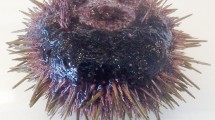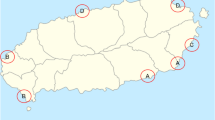Abstract
Vibrio scophthalmi, a bacterial pathogen of olive flounder Paralichthys olivaceus, exhibits strain-dependent virulence. No information is available on the comparative pathogenicity of different strains of V. scophthalmi toward olive flounder. In this study, high- and low-virulence strains (HVS and LVS, respectively) were compared in terms of their pathogenic characteristics, including adhesion and survival, superoxide dismutase (SOD) activity, and extracellular products (ECP) of bacterial cells. The cell-mediated defense of macrophages from olive flounder against V. scophthalmi infection in vitro was also investigated. The results demonstrated that the SOD activity of the HVS was higher than that of the LVS. The number of viable cells of the HVS in serum increased by two log units after 18 h, whereas that of the LVS decreased. The number of cells of the HVS in skin mucus increased significantly while that of the LVS remained constant. The LD50 values of the HVS and LVS ECP toward olive flounder were 10.14 and 15.99 μg protein/g fish, respectively. The ECP were positive for naphthol-AS-BI-phosphohydrolase, lipase, gelatinase, and leucine arylamidase. The extracellular O2 − overflow and intracellular O2 − concentration of macrophages induced by the HVS were lower than those induced by the LVS. Significantly more nitric oxide was produced by the HVS than by the LVS.





Similar content being viewed by others
References
Cerdà-Cuéllar M, Rosselló-Mora RA, Lalucat J, Jofre J, Blanch A (1997) Vibrio scophthalmi sp. nov., a new species from turbot Scophthalmus maximus. Int J Syst Bacteriol 47:58–61
Kang BJ (2003) A study on the characteristics of bacteria isolated from cultured flouders Paralichthys olivaceus showing disease symptoms in Jeju area of Korea, Korea (Ph.D. dissertation). CheJu National University, Jeju
Wang YG, Zhang Z, Qing L (2004) The main diseases of cultured turbot Scophthalmus maximus and their prevention and treatment. Marine Fish Res 25:61–68 (in Chinese with English abstract)
Qiao G, Lee DC, Woo SH, Li H, Xu DH, Park SI (2012) Microbiological characteristics of Vibrio scophthalmi isolates from the diseased olive flounder Paralichthys olivaceus. Fish Sci 78:853–863
Inamura H, Nakai T, Muroga K (1985) An extracellular protease produced by Vibrio anguillarum. Nippon Suisan Gakkaishi 51(2):1915–1920
Lee KK, Liu PC, Kou GH, Chen SN (1997) Investigation on the major exotoxin of Vibrio harveyi 770527 isolated from diseased Penaeus monodon. Rep Fish Dis Res 18:33–42
Montero AB, Austin B (1999) Characterization of extracellular products from an isolate of Vibrio harveyi recovered from diseased post-larval Penaeus vannamei (Bonne). J Fish Dis 22:377–386
Remaley AT, Kuhns DB, Basford RE, Glew RH, Kaplan SS (1984) Leishmanial phosphatase blocks neutrophil O2 − production. J Biol Chem 259:11173–11175
Dettori G, Grillo R, Cattani PO, Calderaro A, Chezzi C, Milner J, Truelove K, Sellwood R (1995) Comparative studies of the enzyme activities of Borelia burgdorferi and other non-intestinal and intestinal spirochaetes. New Microbiol 18(1):12–26
Lindahl M, Faris A, Wadström T, Hjertén S (1981) A new test based on “salting out” to measure relative surface hydrophobicity of bacterial cells. Biochim Biophys Acta 77:471–476
Ljungh A, Wadstrom T (1982) Salt aggregation test for measuring cell surface hydrophobicity of urinary Escherichia coli. Eur J Clin Microbiol 1:388–393
Qiao G, Li H, Xu DH, Park SI (2012) Modified a colony forming unit microbial adherence to hydrocarbons assay and evaluated cell surface hydrophobicity and biofilm production of Vibrio scophthalmi. J Bacteriol Parasitol 3:130. doi:10.4172/2155-9597.1000130
Freeman DJ, Falkiner FR, Keane CT (1989) New method for detecting slime production by coagulase negative Staphylococci. BMC J Clin Pathol 42:872–874
Stepanovic S, Vukovic D, Dakic I, Savic B, Svabić-Vlahovic M (2000) A modified microtiter-plate test for quantification of staphylococcal biofilm formation. J Microbiol Methods 40:175–179
Zhang XH, Austin B (2000) Pathogenicity of Vibrio harveyi to salmonids. J Fish Dis 23:93–102
Bradford MM (1976) Rapid and sensitive method for the quantitation of microgram quantities of protein utilizing the principle of protein-dye binding. Anal Biochem 72:248–254
Muhammad AR (2009) Calculation of LD50 values from the method of Miller and Tainer, 1944. J Ayub Med Coll Abbottabad 21:184–185
Li H, Qiao G, Gu JQ, Zhou W, Li Q, Woo SH, Xu DH, Park SI (2010) Phenotypic and genetic characterization of bacteria isolated from diseased cultured sea cucumber Apostichopus japonicas in northeastern China. Dis Aquat Org 91:223–235
Hertel C, Schmidt G, Fischer M, Oellers K, Hammes WP (1998) Oxygen-dependent regulation of the expression of the catalase gene katA of Lactobacillus sakei LTH677. Appl Environ Microbiol 64(4):1359–1365
Xu XQ, Pan SQ (2000) An Agrobacterium catalase is a virulence factor involved in tumourigenesis. Mol Microbiol 35:407–414
Bordas MA, Baleboña MC, Zorrilla I, Borrego JJ, Morinigo MA (1996) Kinetics of adhesion of selected fish-pathogenic Vibrio strains of skin mucus of gilt–head sea bream Sparus aurata L. Appl Environ Microbiol 62(10):3650–3654
Leung KY, Yeap IV, Lam TJ, Sin YM (1994) Serum resistance as a good indicator for virulence in Aeromonas hydrophila strains isolated from diseased fish in South-East Asia. J Fish Dis 18:511–518
Secombes CJ (1990) Isolation of salmonid macrophages and analysis of their killing activity. In: Stolen JS, Anderson DP, Robertson BS, van Muiswinkel WB (eds) Techniques in fish immunology. SOS Publications, Fair Haven, pp 137–154
Hudson L, Hay FC (1989) Practical immunology. Blackwell, London, p. 507
Seeley KR, Gillespie PD, Weeks BA (1990) A simple technique for the rapid spectrophotometric determination of phagocytosis by fish macrophages. Marine Environ Res 30:37–41
Graham S, Jeffries AH, Secombes CJ (1988) A novel assay to detect macrophage bactericidal activity in fish: factors influencing the killing of Aeromonas salmonicida. J Fish Dis 11(5):389–396
Pick E (1986) Microassays for superoxide and hydrogen peroxide production and nitroblue tetrazolium reduction using an enzyme immunoassay microplate reader. Methods Enzymol 132:407–421
Neumann NF, Fagan D, Belosevic M (1995) Macrophage activating factor(s) secreted by mitogen stimulated goldfish kidney leucocytes synergize with bacterial lipopolysaccharide to induce nitric oxide production in teleost macrophages. Dev Comp Immunol 19(6):473–482
Lee KK, Yii KC (1996) A comparison of three methods for assaying hydrophobicity of pathogenic vibrios. Lett Appl Microbiol 23:343–346
Montgomery MT, Kirchman DL (1994) Induction of chitin-binding proteins during the specific attachment of the marine bacterium Vibrio harveyi to chitin. Appl Environ Microbiol 60:4284–4288
Daly JG, Stevenson RMW (1987) Hydrophobic and haemagglutination properties of Renibacterium salmoninarum. J Gen Microbiol 133:3575–3580
Won KM, Park SI (2008) Pathogenicity of Vibrio harveyi to cultured marine fishes in Korea. Aquaculture 285:8–13
Deziel E, Comeau Y, Villemur R (2001) Initiation of biofilm formation by Pseudomonas aeruginosa 57RP correlated with emergence of hyperpiliated and highly adherent phenotypic variants deficient in swimming, swarming and twitching motilities. J Bacteriol 183:1195–1204
Amaro C, Biosca EG, Esteve C, Fouz B, Toranzo A (1992) Comparative study of phenotypic and virulence properties in Vibrio vulnificus biotype 1 and 2 obtained from a European eel farm experiencing mortalities. Dis Aquat Org 13:29–35
Lee DC (2005) Effect of Edwardsiella tarda ECPs on immune function in olive flounder Paralichthys olivaceus (Ph.D. dissertation). Pukyong National University, Busan
Won KM (2005) Characteristics of non-luminous Vibiro harveyi isolated from maricultured fishes in Korea (Ph.D. dissertation). Pukyong National University, Busan
Shawn MM, Elsayed EE, Mohamed F (2000) Analysis of extracellular proteins of two Perkinsus spp. isolated from the soft shell clam Mya arenaria in vitro. Comp Biochem Physiol Part B Biochem Mol Biol 126:587–598
Michael E, Mylonakis E, Ausubel FM, Calderwood SB, Gilmore MS (2004) Contribution of gelatinase, serine protease and fsr to the pathogenesis of Enterococcus faecalis endophthalmitis. Infect Immun 72(6):3628–3633
Angulo L, Lopez JE, Lema C, Vicente JA (1992) Vibrio pelagius associated with mortalities in farmed turbot. Thalassas 10:129–133
Han HJ, Kim DH, Lee DC, Kim SM, Park SI (2006) Pathogenicity of Edwardsiella tarda to olive flounder Paralichthys olivaceus (Temminck & Schlegel). J Fish Dis 29:601–609
Cline MJ (1975) Chemotaxis, phagocytosis and microbial killing. In: Cline MJ (ed) The white cell. Harvard University Press, Cambridge, pp 71–82
Almagor M, Yatziv S, Kahane I (1983) Inhibition of host cell catalase by Mycoplasma pneumoniae: a possible mechanism for cell injury. Infect Immun 41:251–256
Huycke MM, Abrams V, Moore DR (2002) Enterococcus faecalis produces extracellular super oxide and hydrogen peroxide that damages colonic epithelial cell DNA. Carcinogenesis 23(3):529–536
Barnes AC, Balebona MC, Horne MT, Ellis AE (1999) Superoxide dismutase and catalase in Photobacterium damselae subsp. piscicida and their roles in resistance to reactive oxygen species. Microbiology 145:483–494
Booth NJ, Elkamel A, Thune RL (2006) Intracellular replication of Edwardsiella ictaluri in channel catfish macrophages. J Aquatic Anim Health 18:101–108
Secombes CJ (1996) The nonspecific immune system: cellular defenses. In: Iwama G, Nakanishi T (eds) The fish immune system: organism, pathogen and environment. Academic, San Diego, pp 63–103
Bandin I, Ellis AE, Barja JL, Secombes CJ (1993) Interaction between rainbow trout macrophages and Renibacterium salmoninarumin in vitro. Fish Shellfish Immunol 3:25–33
Leung KY, Low KW, Lam TJ, Sin YM (1995) Interaction of fish pathogen Aeromonas hydrophila with tilapia Oreochromis aureus (Stein-dachner) phagocytes. J Fish Dis 18:435–447
Keiko I, Yamanishi T, Wang YJ, Osatomi K, Hara K, Kana K, Yamaguchi K, Oda T (2009) Comparative analysis of the production of nitric oxide (NO) and tumor necrosis factor-α (TNF-α) from macrophages exposed to high virulent and low virulent strains of Edwardsiella tarda. Fish Shellfish Immunol 27:386–389
Sanchez-Moreno M, Monteoliva-Sanchez M, Ortega F, Ramos-Cormenzana A, Monteoliva M (1989) Superoxide dismutase in strains of the genus Flavobacterium: isolation and characterization. Arch Microbiol 152(4):407–410
Waterstrat PR, Ainsworth AJ, Capley G (1991) In vitro responses of channel catfish Ictalurus punctatus neutrophils to Edwardsiella ictaluri. Dev Comp Immunol 15:53–63
Srinivasa Rao PS, Yamada Y, Leung KY (2003) A major catalase (KatB) that is required for resistance to H2O2 and phagocyte-mediated killing in Edwardsiella tarda. Microbiology 149:2635–2644
Bogdan C, Röllinghoff M, Diefenbach A (2000) The role of nitric oxide in innate immunity. Immunol Rev 173:17–18
Campos-Pérez JJ, Ellis AE, Secombes CJ (2000) Toxicity of nitric oxide and peroxynitrite to bacterial pathogens of fish. Dis Aquat Org 43:109–115
Nathan CF, Xie Q (1994) Regulation of biosynthesis of nitric oxide. J Bio Chem 269:13725–13728
Rodrĺguez I, Novoa B, Figueras A (2008) Immune response of zebra fish Danio rerio against a newly isolated bacterial pathogen Aeromonas hydrophila. Fish Shellfish Immunol 25:239–249
Qin QW, Ototake M, Noguchi K, Soma GI, Yokomizo Y, Nakanishi T (2001) Tumor necrosis factor alpha (TNF-α)-like factor produced by macrophages in rainbow trout Oncorhynchus mykiss. Fish Shellfish Immunol 11:245–256
Pietsch C, Vogt R, Neumann N, Kloas W (2008) Production of nitric oxide by carp Cyprinus carpio L. kidney leukocytes is regulated by cyclic 30, 50-adenosine monophosphate. Comp Biochem Physiol A Mol Int Physiol 150:58–65
Freudenberg MA, Galanos C (1991) Tumor necrosis factor alpha mediates lethal activity of killed Gram-negative and Gram-positive bacteria in d-galactosamine-treated mice. Infect Immun 59:2110–2115
Braun JS, Novak R, Gao G, Murray PJ, Shenep JL (1999) Pneumolysin, a protein toxin of Streptococcus pneumoniae, induces nitric oxide production from macrophages. Infect Immun 67:3750–3756
Thiemermann C (1997) Nitric oxide and septic shock. Gen Pharmac 29:159–166
Waage A (1998) Tumour necrosis factor and septic shock. Lancet 351:603
Leist M, Gantner F, Bohlinger I, Tiegs G, Germann PG, Wendel A (1995) Tumor necrosis factor-induced hepatocyte apoptosis precedes liver failure in experimental murine shock models. Am J Pathol 146:1220–1234
Author information
Authors and Affiliations
Corresponding author
Rights and permissions
About this article
Cite this article
Qiao, G., Jang, IK., Won, K.M. et al. Pathogenicity comparison of high- and low-virulence strains of Vibrio scophthalmi in olive flounder Paralichthys olivaceus . Fish Sci 79, 99–109 (2013). https://doi.org/10.1007/s12562-012-0567-4
Received:
Accepted:
Published:
Issue Date:
DOI: https://doi.org/10.1007/s12562-012-0567-4




